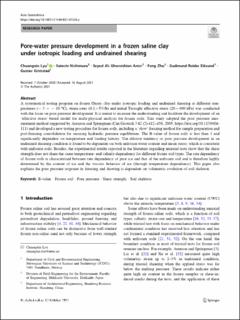| dc.contributor.author | Lyu, Chuangxin | |
| dc.contributor.author | Nishimura, Satoshi | |
| dc.contributor.author | Ghoreishian Amiri, Seyed Ali | |
| dc.contributor.author | Zhu, Feng | |
| dc.contributor.author | Eiksund, Gudmund Reidar | |
| dc.contributor.author | Grimstad, Gustav | |
| dc.date.accessioned | 2022-02-15T13:15:24Z | |
| dc.date.available | 2022-02-15T13:15:24Z | |
| dc.date.created | 2021-10-25T13:12:54Z | |
| dc.date.issued | 2021 | |
| dc.identifier.citation | Acta Geotechnica. 2021, . | en_US |
| dc.identifier.issn | 1861-1125 | |
| dc.identifier.uri | https://hdl.handle.net/11250/2979130 | |
| dc.description.abstract | A systematical testing program on frozen Onsøy clay under isotropic loading and undrained shearing at different temperatures (− 3 ~ − 10 °C), strain rates (0.2~5%/h) and initial Terzaghi effective stress (20~400 kPa) was conducted with the focus on pore pressure development. It is meant to increase the understanding and facilitate the development of an ‘effective stress’-based model for multi-physical analysis for frozen soils. This study adopted the pore pressure measurement method suggested by Arenson and Springman (Can Geotech J 42 (2):412–430, 2005. https://doi.org/10.1139/t04-111) and developed a new testing procedure for frozen soils, including a ‘slow’ freezing method for sample preparation and post-freezing consolidation for securing hydraulic pressure equilibrium. The B-value of frozen soils is less than 1 and significantly dependent on temperature and loading history. The dilative tendency or pore pressure development in an undrained shearing condition is found to be dependent on both unfrozen water content and mean stress, which is consistent with unfrozen soils. Besides, the experimental results reported in the literature regarding uniaxial tests show that the shear strength does not share the same temperature- and salinity-dependency for different frozen soil types. The rate dependency of frozen soils is characterized between rate dependency of pure ice and that of the unfrozen soil and is therefore highly determined by the content of ice and the viscous behavior of ice (through temperature dependency). This paper also explains the pore pressure response in freezing and thawing is dependent on volumetric evolution of soil skeleton. | en_US |
| dc.language.iso | eng | en_US |
| dc.publisher | Springer | en_US |
| dc.rights | Navngivelse 4.0 Internasjonal | * |
| dc.rights.uri | http://creativecommons.org/licenses/by/4.0/deed.no | * |
| dc.title | Pore-water pressure development in a frozen saline clay under isotropic loading and undrained shearing | en_US |
| dc.type | Peer reviewed | en_US |
| dc.type | Journal article | en_US |
| dc.description.version | publishedVersion | en_US |
| dc.source.pagenumber | 17 | en_US |
| dc.source.journal | Acta Geotechnica | en_US |
| dc.identifier.doi | 10.1007/s11440-021-01338-y | |
| dc.identifier.cristin | 1948232 | |
| dc.relation.project | EC/H2020/773421 | en_US |
| dc.relation.project | Norges forskningsråd: 262644 | en_US |
| cristin.ispublished | true | |
| cristin.fulltext | original | |
| cristin.qualitycode | 1 | |

